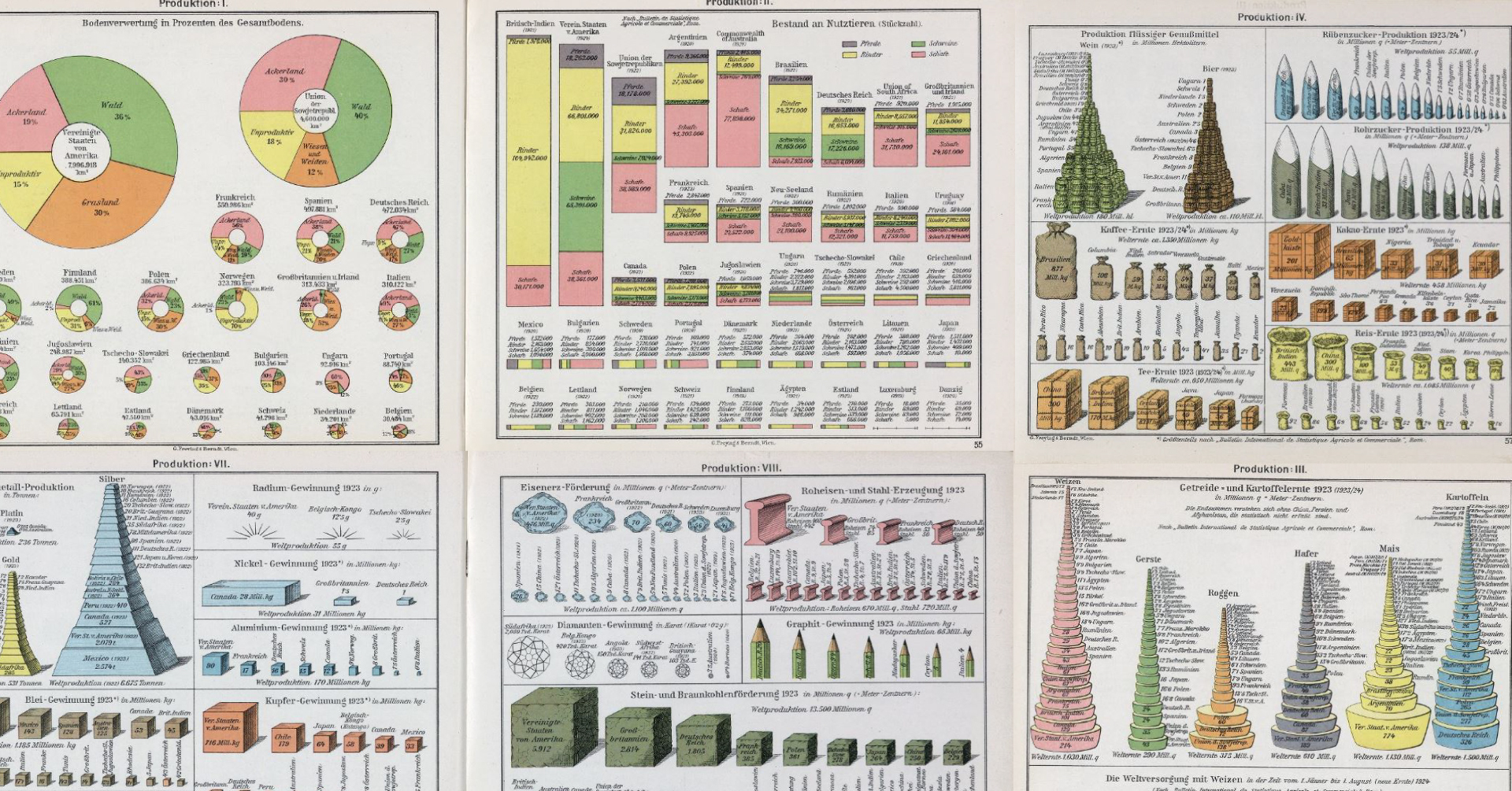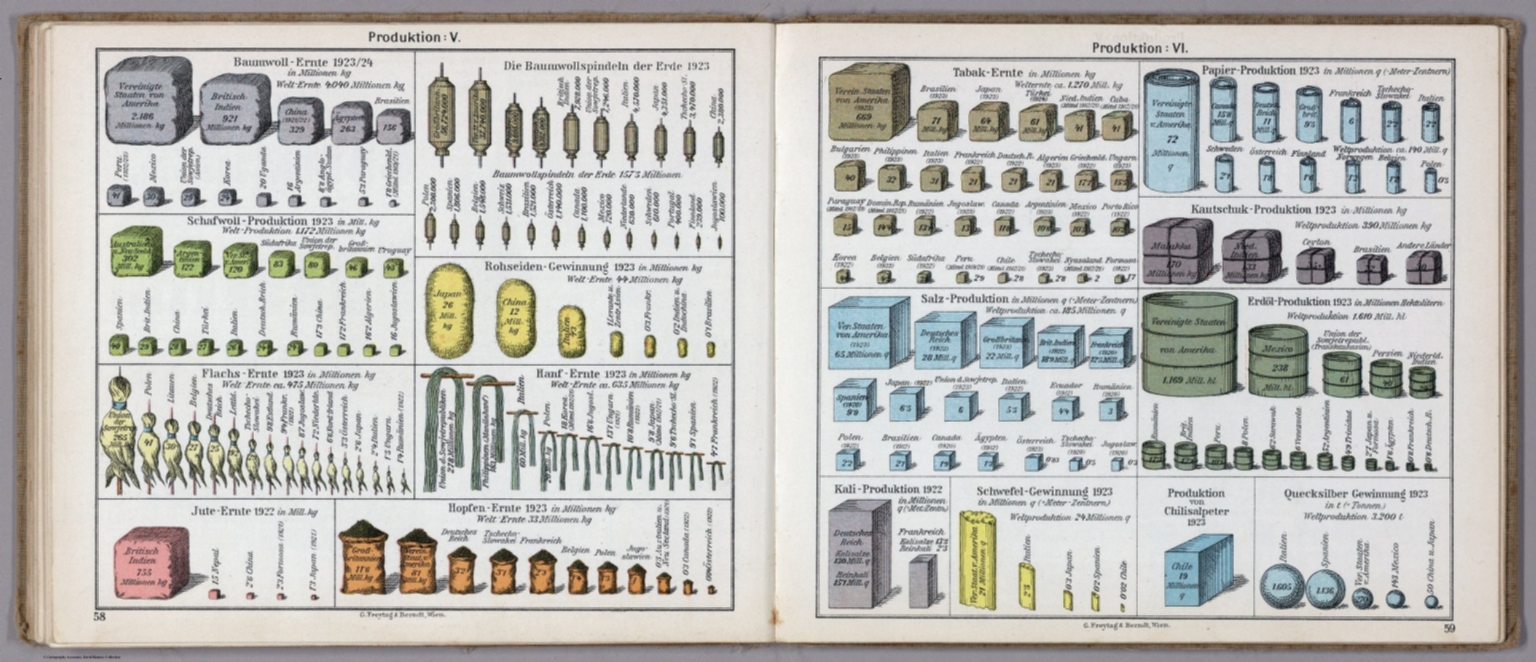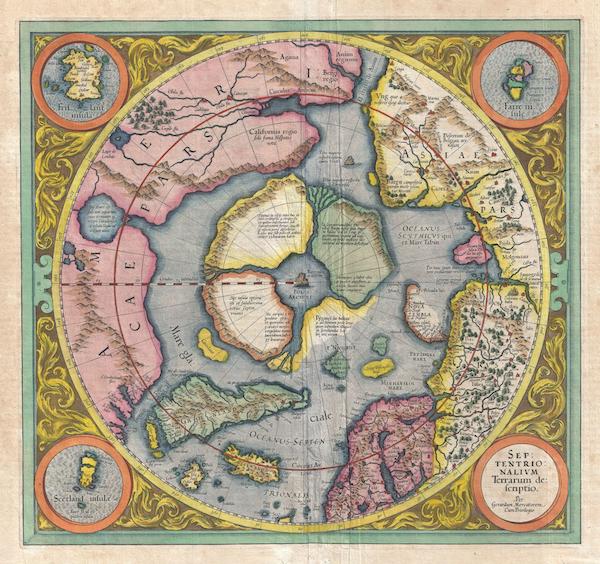
Visualizing Global Commodity Production in the 1920s
This map is the latest in our Vintage Viz series, which presents historical visualizations along with the context needed to understand them.
The year was 1927. Art deco and surrealism were making their debut, the Jazz Age was in full swing, and depending on where you lived, you called this decade either roaring (U.S.), golden (Germany), or even crazy (France).
The second decade of the 20th century was also a period of rapid economic expansion, as Fordism and mass consumer culture took hold in the years following World War I. And nowhere is that more apparent than in the 1927 edition of Prof. Hickmann’s Universal Geographical and Statistical Atlas.
Published in German by the Austrian publisher G. Freytag & Berndt, the atlas contains 80 pages of statistics, charts, and visualizations on a range of themes. In this edition of Vintage Viz, we take a look at just eight of those pages, which cover global commodity production.
Translations: Sprechen Sie Deutsche?
To help out those of us who don’t read German, we’ve included translations of the major content below; just click to expand the items.
Ländernamen : country names
- Ägypten : Egypt
- Algerien : Algeria
- Arabien : Arabia
- Argentinien : Argentina
- Australien : Australia
- Belgien : Belgium
- Belgien Kongo : Belgium Congo
- Brasilien : Brazil
- Britisch-Indien : British India (aka British Raj)
- Bulgarien : Bulgaria
- Ceylon : present-day Sri Lanka
- Danemark : Denmark
- Danzig : Gdansk (Danzig or Gdansk is now part of Poland, but was a free city under the administration of the League of Nations during the interwar period)
- Deutsches Reich : Germany
- Dominik Republik : Dominican Republic
- Elfenbeinküste : Ivory Coast
- Estland : Estonia
- Fernando Poo : Bioko island, now part of Equatorial New Guinea
- Finnland : Finland
- Formosa : Present-day Taiwan
- Frankreich : France
- Französisch Indochina : Vietnam
- Französisch Marakko : French Morocco
- Griechenland : Greece
- Großbritannien und Irland : UK
- Italien : Italy
- Italien Somali : Italian Somalia
- Irischer Freistaat : Irish Free State (post-1922)
- Jamaika : Jamaica
- Jugoslawien : Yugoslavia
- Korea : Korea (united and part of the Japanese Empire)
- Lettland : Latvia
- Litauen : Lithuania
- Madagaskar : Madagascar
- Malakka : Malaysia
- Mittelamerika : Central America
- Neu-Seeland : New Zealand
- Niederlande : Netherlands
- Nied(er) Indien : Lower India
- Norwegen : Norway
- Nyasaland : present-day Malawi
- Österreich : Austria
- Persien : Iran
- Philippinen : Philippines
- Polen: Poland
- Portugal : Portugal
- Rumänien : Romania
- Saargebiet : Saar region
- Spanien : Spain
- Schweden : Sweden
- Schweiz : Switzerland
- Süd Afrika : South Africa
- Süd Amerika : South America
- Süd Rhodesia : Southern Rhodesia
- Syrien : Syria
- Tanganjikaland : present-day Tanzania
- Tschecho-Slowakei : Czechoslovakia
- Tunis : Tunisia
- Türkei : Türkiye
- Ungarn : Hungary
- Union der Sowjetrepubliken : Union of Soviet Socialist Republics
- Vereinigte Staaten von Amerika : United States of America
- Welt : World
Expand to show country namesa.bg-showmore-plg-link:hover,a.bg-showmore-plg-link:active,a.bg-showmore-plg-link:focus{color:#0071bb;}
Agricultural Production
Click on graphics to view them in high resolution.

Translations: Produktion I
- Bodenverwertung in Prozenten des Gesamtbodens : Soil utilization as a percentage of total soil
- Ackerland : arable
- Wald : woodland
- Grasland : grassland
- Wiesen und Weiden : Meadows and pastures
- Unproduktiv : unproductive
Expand to show termsa.bg-showmore-plg-link:hover,a.bg-showmore-plg-link:active,a.bg-showmore-plg-link:focus{color:#0071bb;}
Translations: Produktion II
- Bestand an Nutztieren (Stuckzahl) : Livestock population (number of head)
- Pferde : horses
- Rinder : cattle
- Schweine : pigs
- Schafe : sheep
Expand to show termsa.bg-showmore-plg-link:hover,a.bg-showmore-plg-link:active,a.bg-showmore-plg-link:focus{color:#0071bb;}
Produktion I covers land-use (Bodenverwertung in Prozenten des Gesamtbodens) by country. Finland, with its vast tracts of boreal forest, had the largest share of woodlands at 61% of total land coverage. According to 2021 figures from the World Bank, Finland’s forests have actually grown since then, now covering 73.7% of the country. France had the highest proportion of arable land, at 56%, while Norway, with its rugged northern geography, had the largest share of “unproductive” land at 70%.
Turning to livestock, the biggest producer was British India (then a colony), with 197 million heads of horse, cattle, sheep, and pigs. In a close second was the U.S., with 188 million head. Note that livestock statistics don’t all come from the same year.
Grains and Potatoes, Beer and Wine
Click on graphics to view them in high resolution.

Translations: Produktion III
- Getreide- und Kartoffelernte : Grain and Potato Harvest
- Weizen : wheat
- Gerste : barley
- Roggen : rye
- Hafer : oats
- Mais : corn
- Kartoffeln : potatoes
- Die Welversorgung mit Weizen in der Zeit 1 Janner bis 1 August (neue Ernste) 1924 : The world supply of wheat in the period 1 January to 1 August (new harvest) 1924
- Am 1 Janner 1924 ausfuhrverfügbare Vorräte in den Ubershusslandern : Exportable stocks in the surplus countries on 1 January 1924
- Angenommener Höchsfehlbedarf Vorräte in den Uberschusslandern : Assumed shortfall in the surplus countries
Expand to show termsa.bg-showmore-plg-link:hover,a.bg-showmore-plg-link:active,a.bg-showmore-plg-link:focus{color:#0071bb;}
Translations: Produktion IV
- Produktion flüssiger Genussmittel : Production of liquid food stuffs
- Wein : wine
- Bier : beer
- Kafee-Ernte : coffee harvest
- Tee-Ernte : tea harvest
- Rübenzucker-Produktion : sugar beat production
- Rohrzucker-Produktion : cane sugar production
- Kakao-Ernte : cocoa harvest
- Reis-Ernt : rice harvest
Expand to show termsa.bg-showmore-plg-link:hover,a.bg-showmore-plg-link:active,a.bg-showmore-plg-link:focus{color:#0071bb;}
On Produktion III, we see that the U.S. was an agricultural powerhouse, producing the largest amounts of most grains, except for rye where the U.S.S.R. was first, and potatoes where Germany was top spud. The bottom visualization shows how surplus grain moved from exporting agricultural producers (Argentina, Canada, the U.S., etc…) to grain importing nations, including the UK and Germany.
On Produktion IV, we have the production of wine and beer, depicted as stacks of barrels. Perhaps it’s no surprise that France edged out Italy as the top wine producer in 1923, while the UK was just ahead of Germany for first place in beer production at 30 million hectoliters (a hectoliter is 100 liters).
Wool and Silk, Oil and Quicksilver
Click on graphics to view them in high resolution.

Translations: Produktion V
- Baumwoll-Ernte : cotton harvest
- Schafwoll-Produktion : sheep’s wool harvest
- Flachs-Ernte : Flax harvest
- Die Baumwollsindeln der Erde : Global cotton spindle amounts
- Rohseiden-Gewinnung : raw silk cultivation
- Hanf-Ernte : hemp harvest
- Hopfen-Ernte : hops harvest
Expand to show termsa.bg-showmore-plg-link:hover,a.bg-showmore-plg-link:active,a.bg-showmore-plg-link:focus{color:#0071bb;}
Translations: Produktion VI
- Tabak-Ernte : Tobacco harvest
- Papier-Produktion : paper production
- Kautschuk-Produktion : rubber production
- Salz-Produktion : salt production
- Erdol- Produktion : petroleum production
- Kali-Produktion : potash production
- Schwefel-Gewinnung : sulphur extraction
- Produktion von Chilisaltpeter : Chilean saltpeter
- Quecksilber-Gewinnung : Mercury extraction
Expand to show termsa.bg-showmore-plg-link:hover,a.bg-showmore-plg-link:active,a.bg-showmore-plg-link:focus{color:#0071bb;}
On Produktion V we have textiles, including silk production. Historically, the cultivation of silk was restricted to China, where it was guarded as a state secret. The story goes that two sixth-century monks smuggled silkworm eggs out of the country hidden in a bamboo pole and presented them to the Byzantine court of Justinian I. Eventually, the secret made its way to the Arabs, then to Italy and later France by returning Crusaders.
Perhaps most interesting on Produktion VI is the breakdown of oil producers. One hundred years ago, the top producer was the U.S., a position that it has recently retaken thanks to the shale revolution. Figures are presented in millions of hectoliters but converted into barrels, the U.S produced just over 753,000 barrels in 1923. To put that in perspective, the U.S. produced 21.4 million barrels of oil every day in the fourth quarter of 2023.
Metals and Gems, Coal and Coke
Click on graphics to view them in high resolution.

Translations: Produktion VII
- Edelmetall-Produktion : precious metal production
- Platin : platinum
- Gold : gold
- Silber : silver
- Radium-Gewinnung : radium extraction
- Nickel-Gewinnung : nickel extraction
- Aluminium-Gewinnung : aluminum extraction
- Blei-Gewinnung : lead extraction
- Kupfer-Gewinnung : copper
Expand to show termsa.bg-showmore-plg-link:hover,a.bg-showmore-plg-link:active,a.bg-showmore-plg-link:focus{color:#0071bb;}
Translations: Produktion VIII
- Eisenerz-Förderung : Iron ore mining
- Roheisen- und Stahl-Erzeugung : Pig iron and steel production
- Diamanten-Gewinnung : diamond mining
- Graphit-Gewinnung : graphite mining
- Stein- und Braunkohlenförderung : coal and lignite mining
- Koks-Gewinnung in Zechen und Hutten : coke mining in collieries and mines
- Gaskoks-Gewinnung : gas coke
Expand to show termsa.bg-showmore-plg-link:hover,a.bg-showmore-plg-link:active,a.bg-showmore-plg-link:focus{color:#0071bb;}
On Produktion VII and VIII, we have a breakdown of global mining output for a variety of strategic and precious metals. Back then, South Africa was the world’s largest gold producer at 285 metric tons, as well as the top diamond producer (2 million carats), while Mexico was 1923’s largest silver producer.
Strategic metals, on the other hand, were produced mainly by Western industrialized countries of the day. The U.S., which had overtaken the UK as the world’s largest economy following WWI, was the largest producer of pig iron and steel, iron ore, coke, and coal and lignite. The UK only maintained its lead in the production of gas coke.
A Last Gasp Before a Fall
The atlas presents a snapshot of a world on the cusp of the Great Depression, and if we looked at a version published just a few short years later it would likely show a remarkably different picture. Instead of a time of economic growth and increased exports, it was one of unemployment, isolationism, and eventually, clouded by war.
But in 1927, the Goldene Zwanziger Jahre—the Golden Twenties as they were called in Germany—were still going strong.
 |
Want to dive deeper into more vintage maps and visualizations?
VC+ members will be receiving a special feature in their inboxes on Wednesday, December 27th, 2023 deconstructing three historical maps that got it (very) wrong. VC+ gives access to:
Find out more |
The post Visualizing Global Commodity Production in the 1920s appeared first on Visual Capitalist.